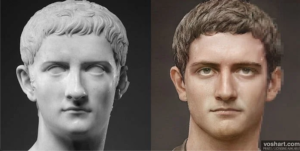The final chapters of Roldán’s book, which revolve around the assassination of Caligula by patriotic Romans (like the patriots who killed Julius Caesar) are the most intense. The previous chapters, which I won’t quote either, show how the young Gaius became a sort of cruel, unjust and crazy Joffrey Baratheon, the 18th king to rule from the Iron Throne in George R.R. Martin’s fantasy world.
In one of the final pages of Calígula we see that the Roman Senate apparently had a golden opportunity to reinstate the Republic, but according to the author it was already very decadent times and there was no way back for the Empire. Claudius was made the new Emperor.
One of the reasons I don’t like the art of writing is that I can only think in visual terms. As some people know, when I was a kid I wanted to be a film director. If I can’t see the ethnic group to which the Roman Senate belonged from centuries before our era until its abolition in the Christian era, I can’t know what was going on. I need the picture.
That’s why I got so hooked on Martin’s metaphor of the Weirwood to see the historical past of Westeros. What if, in the real world, I could see how Nordic the early Roman kings, senators and aristocracy of the Republican period were, and finally see, in full colour as Martin’s greenseers could, the skin, eye and hair of later eras? This would mean visiting Rome thirteen or fourteen times, with leaps of one visit per century from the 8th century b.c.e. to the 5th century c.e.
The reason I am not interested in Roldán’s prose or any other conventional historian is that I am tremendously influenced by William Pierce, Eduardo Velasco and Arthur Kemp as far as history is concerned (they all appear in The Fair Race). These authors say that, gradually, the Greeks and Romans interbred with mudbloods losing their Nordic look after a few centuries.
What’s the use of reading dry words from Roldán’s book if I can’t see the senators from the time before the Punic Wars and the senators of Caligula’s time? The loyalty one feels for almost identical people is not the same as with mixed people. Now I am reminded of a 1962 film, Advise & Consent about American Senators, based on a Pulitzer Prize-winning novel of the same title: white male senators. Compare that black-and-white film with today’s senatorial Babel in the same country, where ethnicity matters and dictates the agenda.
I can only think, as I said, in visual terms but normie historians live in a world of abstract ideas insofar as they don’t know that race, and ethnic allegiance of a homogeneous group, matters.
If I had the financial means, my way of doing history would be to try to find the tombs of these ancient Romans, date them with carbon-14 and reconstruct their faces (in much the same way as above we can see the face of Caligula) to see if we can corroborate the thesis of Pierce, Velasco and Kemp.
At the academic level, Martin Nilson (1874-1967), the Swedish scholar of the classical world, went so far as to say that the mixing of blood was the ultimate cause of the decline and fall of Rome. Such research is forbidden today. But only from such a premise, and with the consequent images such as the reconstructed heads of the ancient Romans from their skulls could I, with the technological means we already possess, approach the fantastic idea of seeing the past as it happened.

2 replies on “Caligula, 7”
Absolutely agree with historians and their blindness to races of men. Thanks to William Pierce and Arthur Kemp works, I was able to understand more this missing piece of the puzzle.
“The loyalty one feels for almost identical people is not the same as with mixed people.”
There is no loyalty or sense of belonging to mixed people. You instinctively want to stick to those who look like you and resemble you the most. It is healthy and denying this is sickening.
Have you seen ads and advertisement in countries with strong Nordic element? They are portrayed mostly with blonde haired and blue eyed people. The Nordic ideal is still alive and they stick to their own.
Mauricio idea of creating our own art through AI is fabulous. If you type the right prompt words, you can get decent results.
You could try this on: https://www.craiyon.com/
Type : “Marcus Aurelius as real man with blonde hair and dark blue eyes”
(On negative words tab, type “statue”)
Yes: there have been studies of how Aryan the Roman emperors were. There’s an article in The Fair Race, ‘Were the Greeks and Romans blond and blue-eyed?’ See esp. pages 340-342.